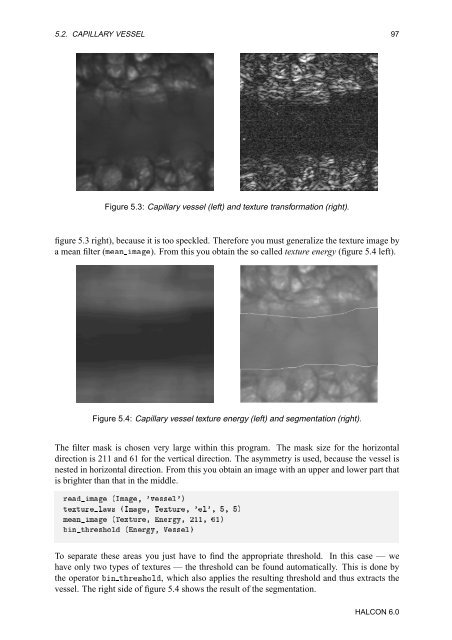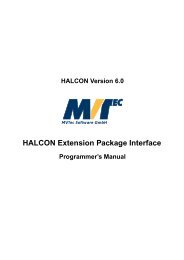Create successful ePaper yourself
Turn your PDF publications into a flip-book with our unique Google optimized e-Paper software.
5.2. CAPILLARY VESSEL 97<br />
Figure 5.3: Capillary vessel (left) and texture transformation (right).<br />
figure 5.3 right), because it is too speckled. Therefore you must generalize the texture image by<br />
ameanfilter(ÑÒ Ñ). From this you obtain the so called texture energy (figure 5.4 left).<br />
Figure 5.4: Capillary vessel texture energy (left) and segmentation (right).<br />
The filter mask is chosen very large within this program. The mask size for the horizontal<br />
direction is 211 and 61 for the vertical direction. The asymmetry is used, because the vessel is<br />
nested in horizontal direction. From this you obtain an image with an upper and lower part that<br />
is brighter than that in the middle.<br />
ÖÑ ´ÁѸ ³Ú××гµ<br />
ØÜØÙÖÐÛ× ´ÁѸ ÌÜØÙÖ¸ ³Ð³¸ ¸ µ<br />
ÑÒÑ ´ÌÜØÙÖ¸ ÒÖݸ ¾½½¸ ½µ<br />
ÒØÖ×ÓÐ ´ÒÖݸ Î××е<br />
To separate these areas you just have to find the appropriate threshold. In this case — we<br />
have only two types of textures — the threshold can be found automatically. This is done by<br />
the operator Ò ØÖ×ÓÐ, which also applies the resulting threshold and thus extracts the<br />
vessel. The right side of figure 5.4 shows the result of the segmentation.<br />
HALCON 6.0
















